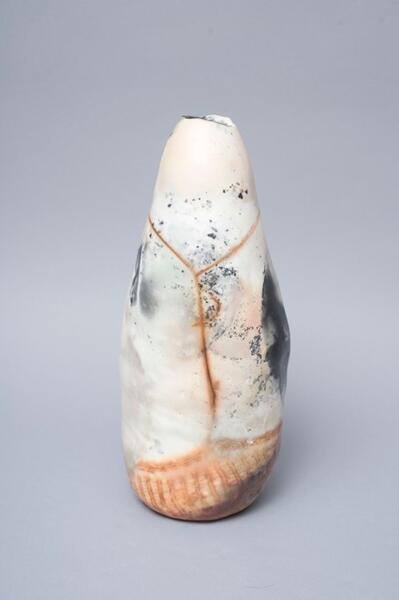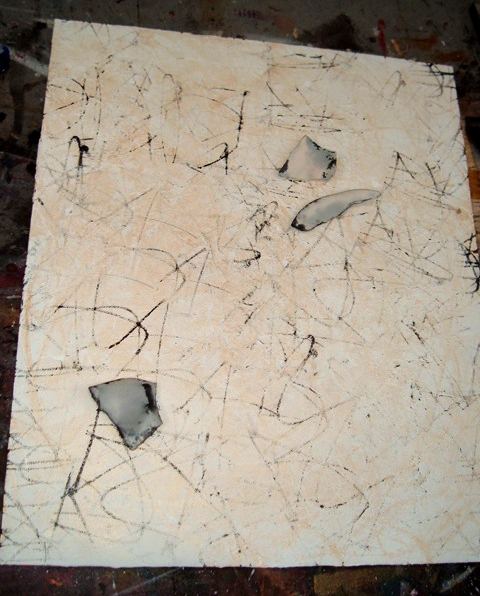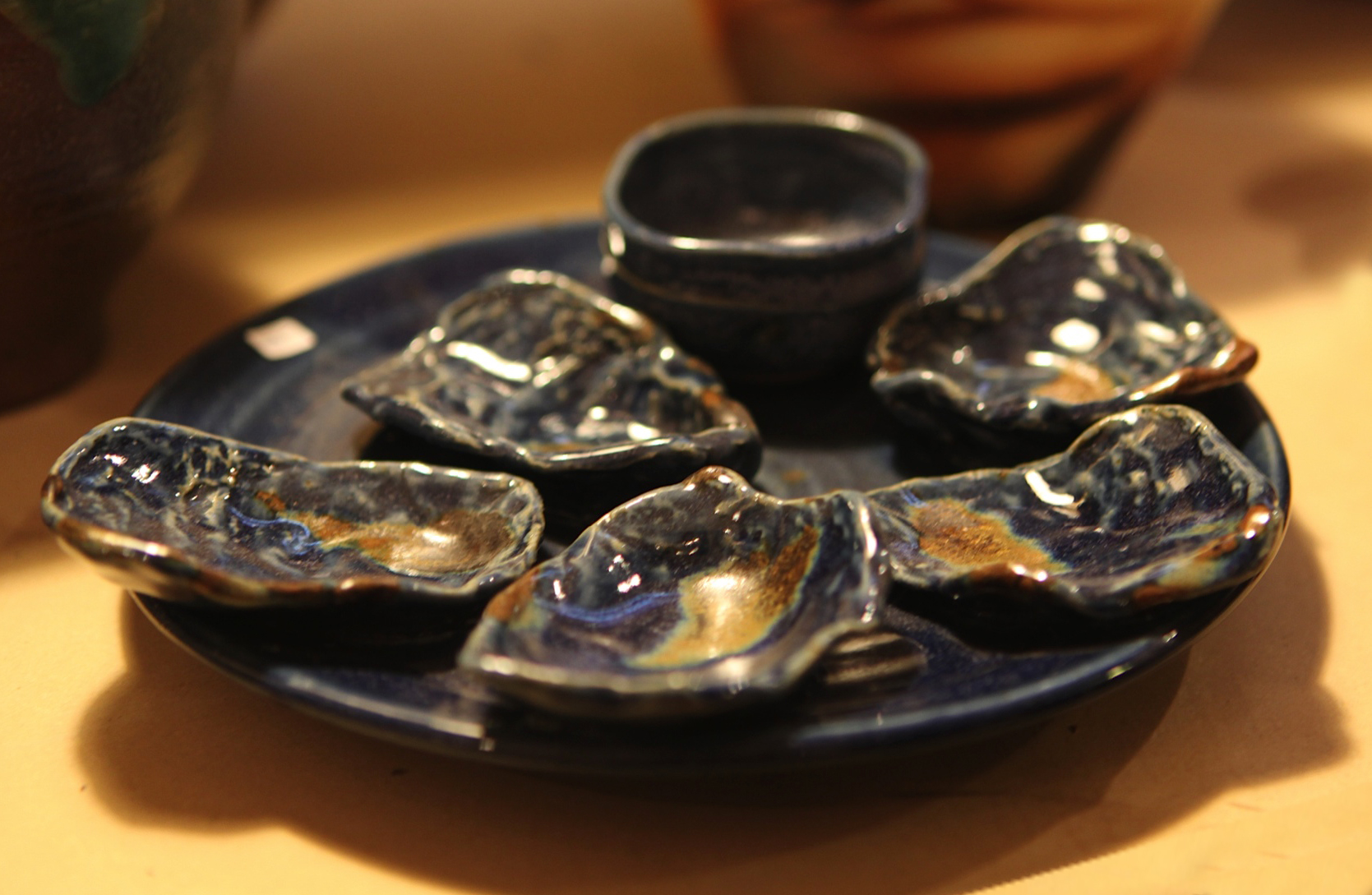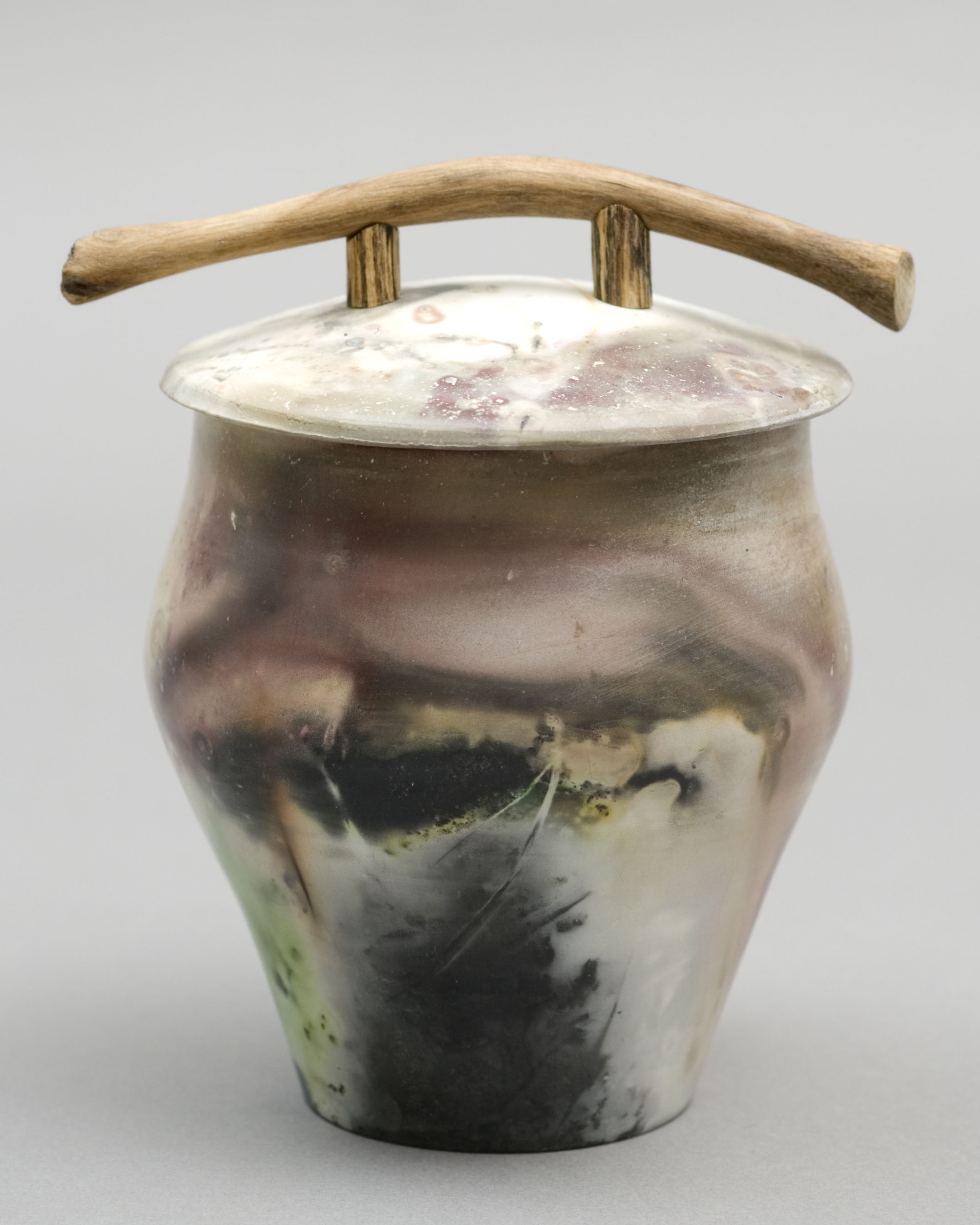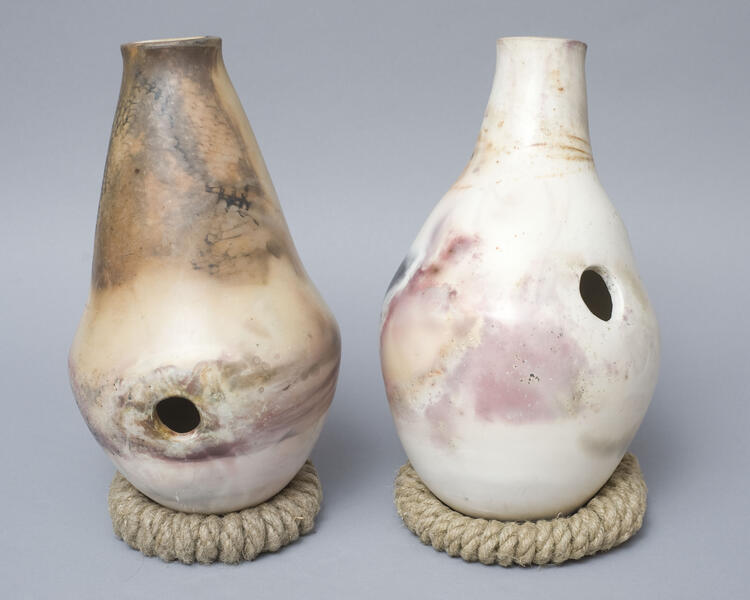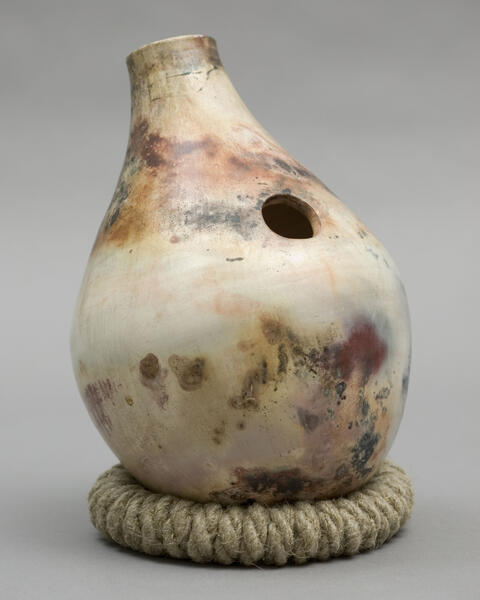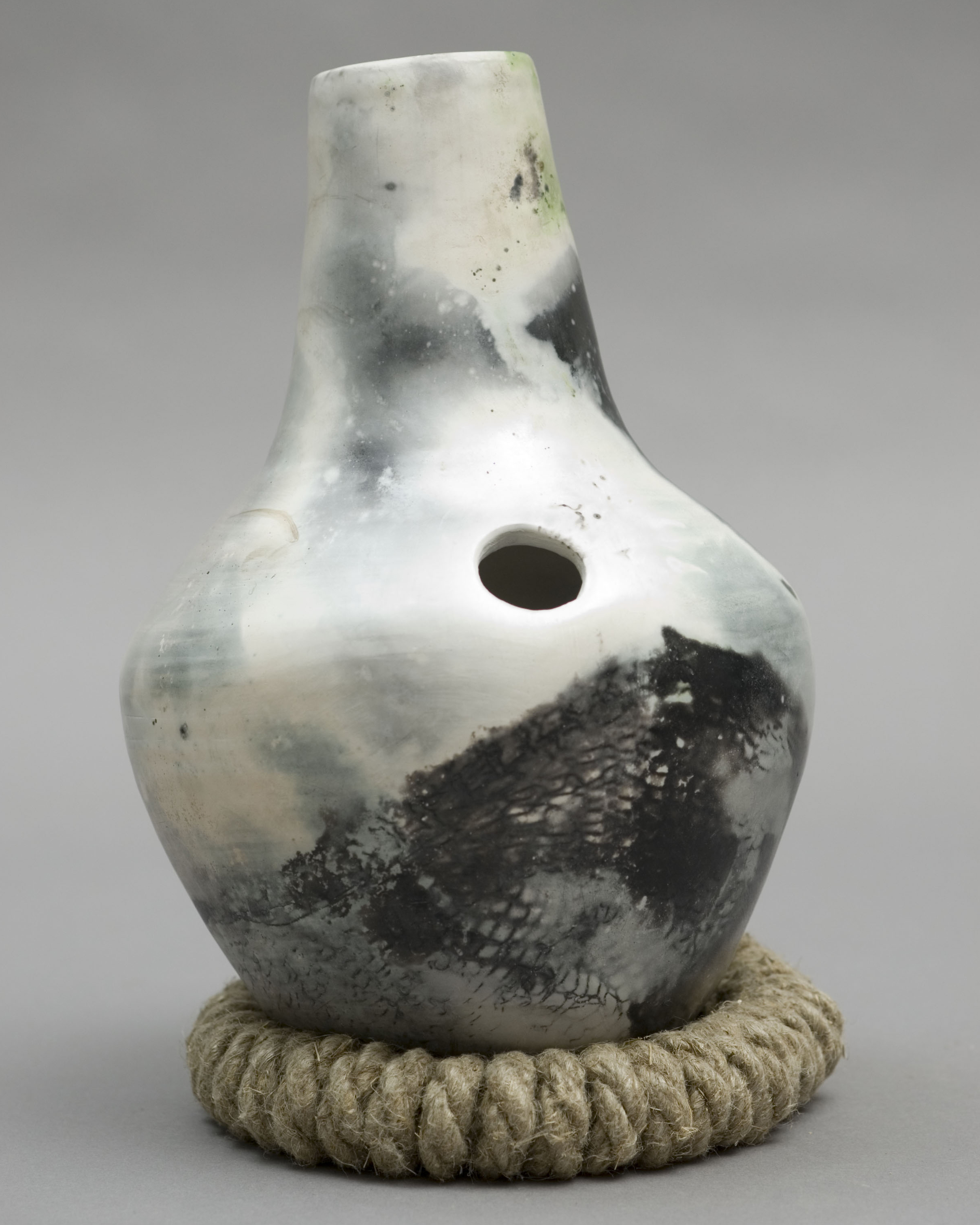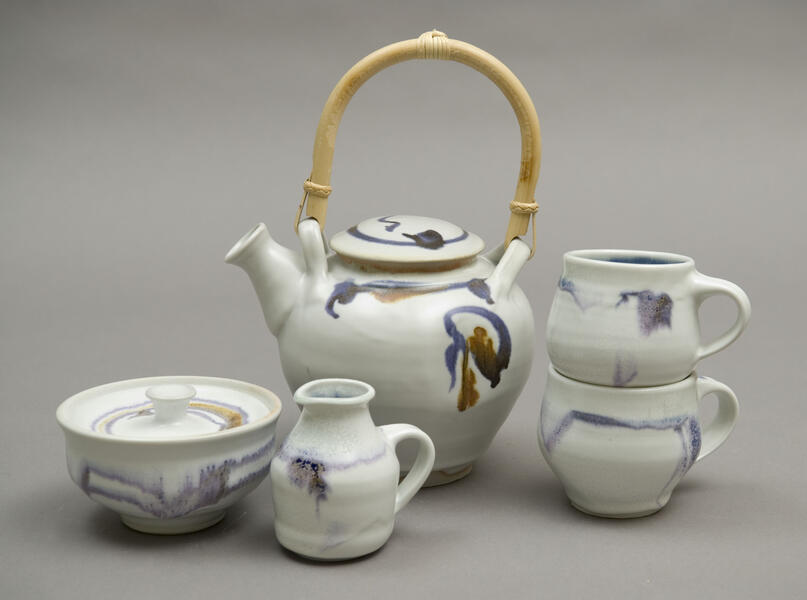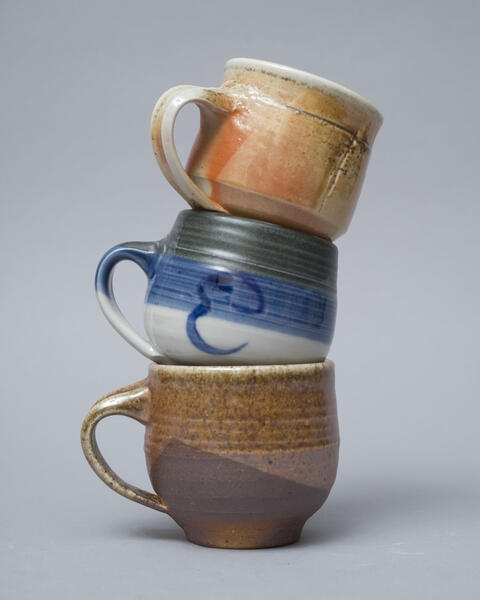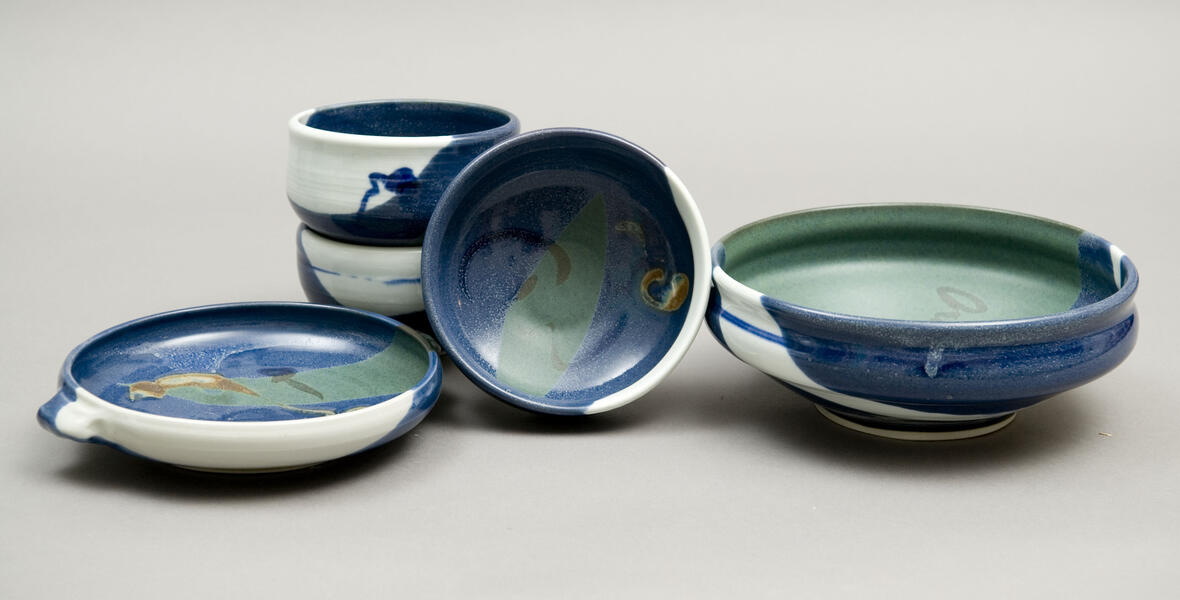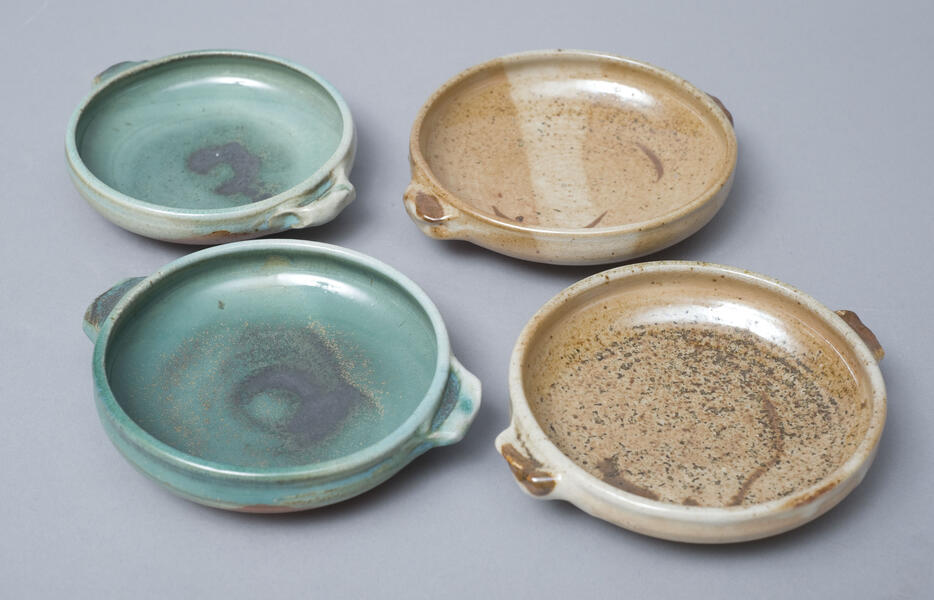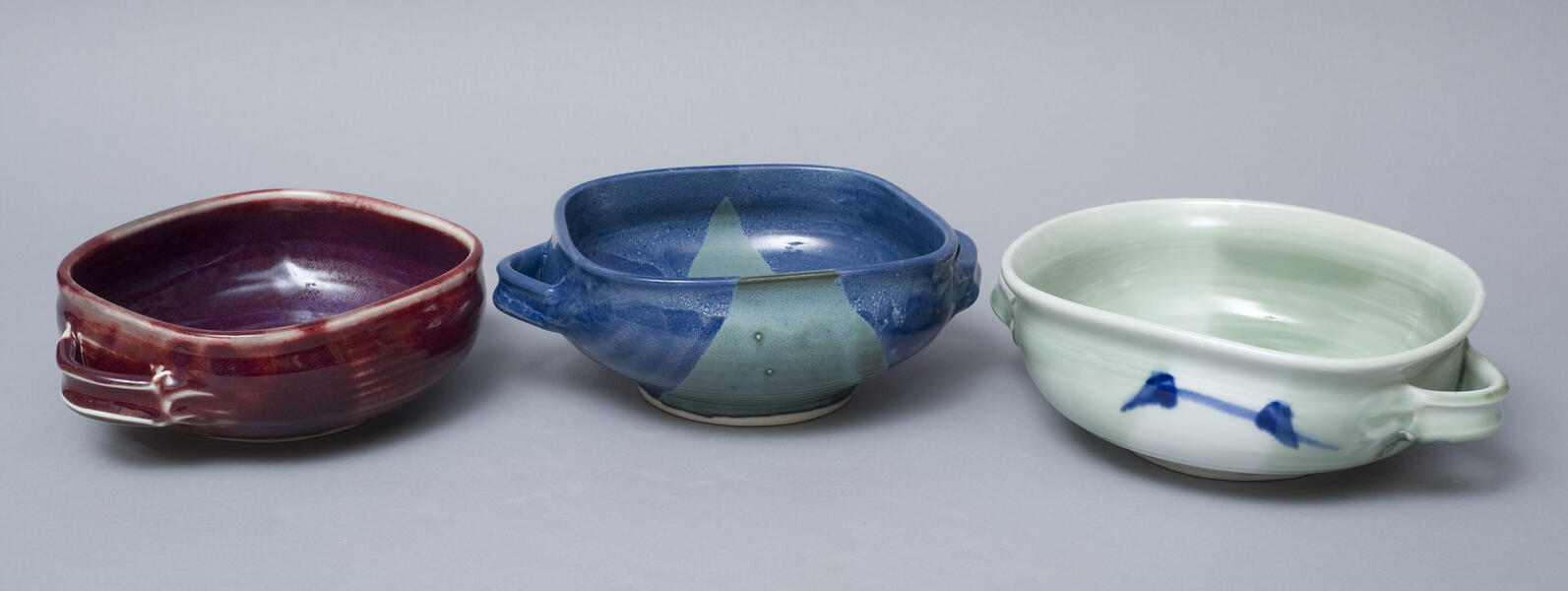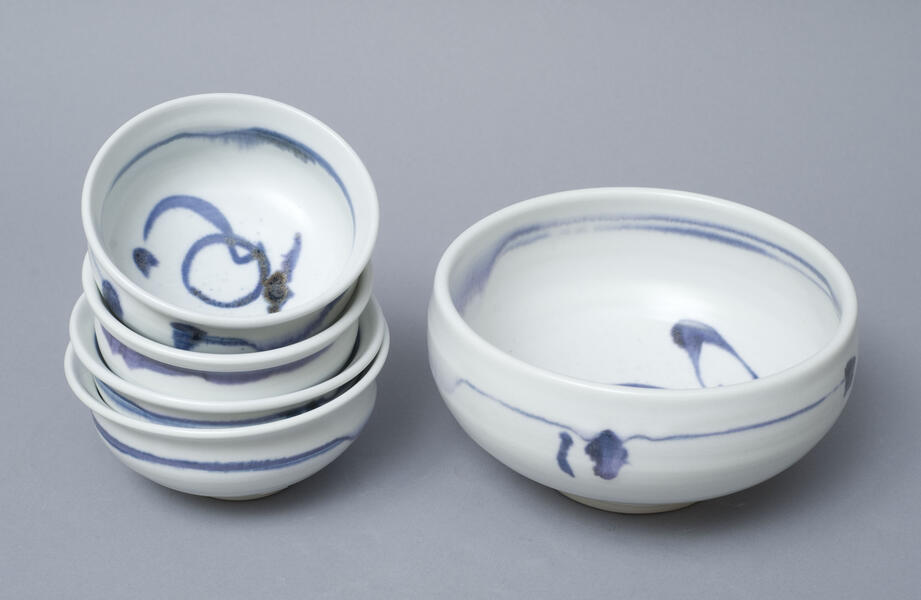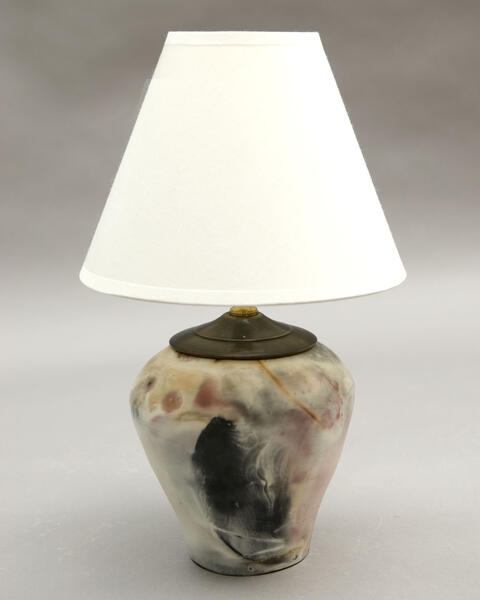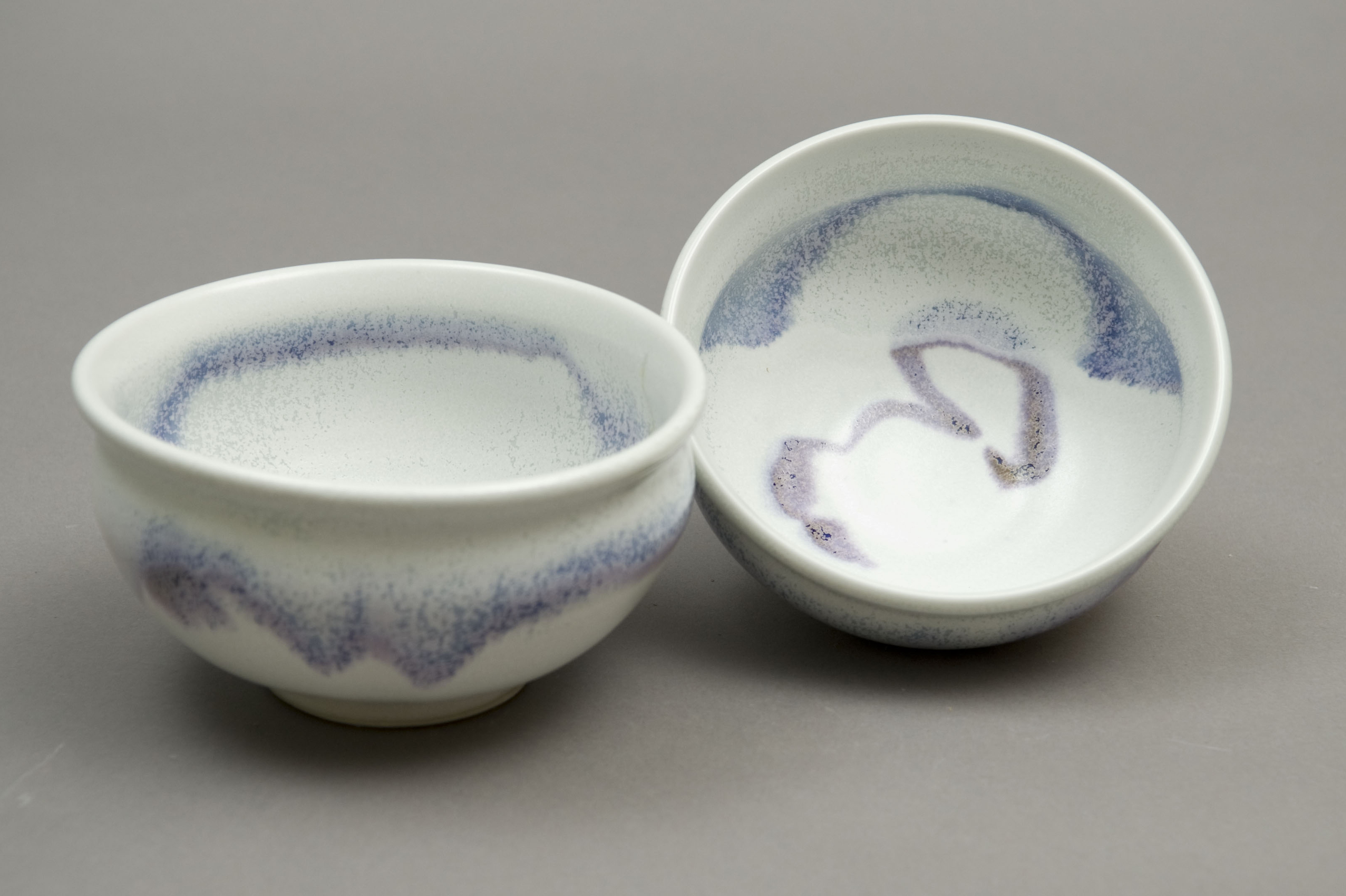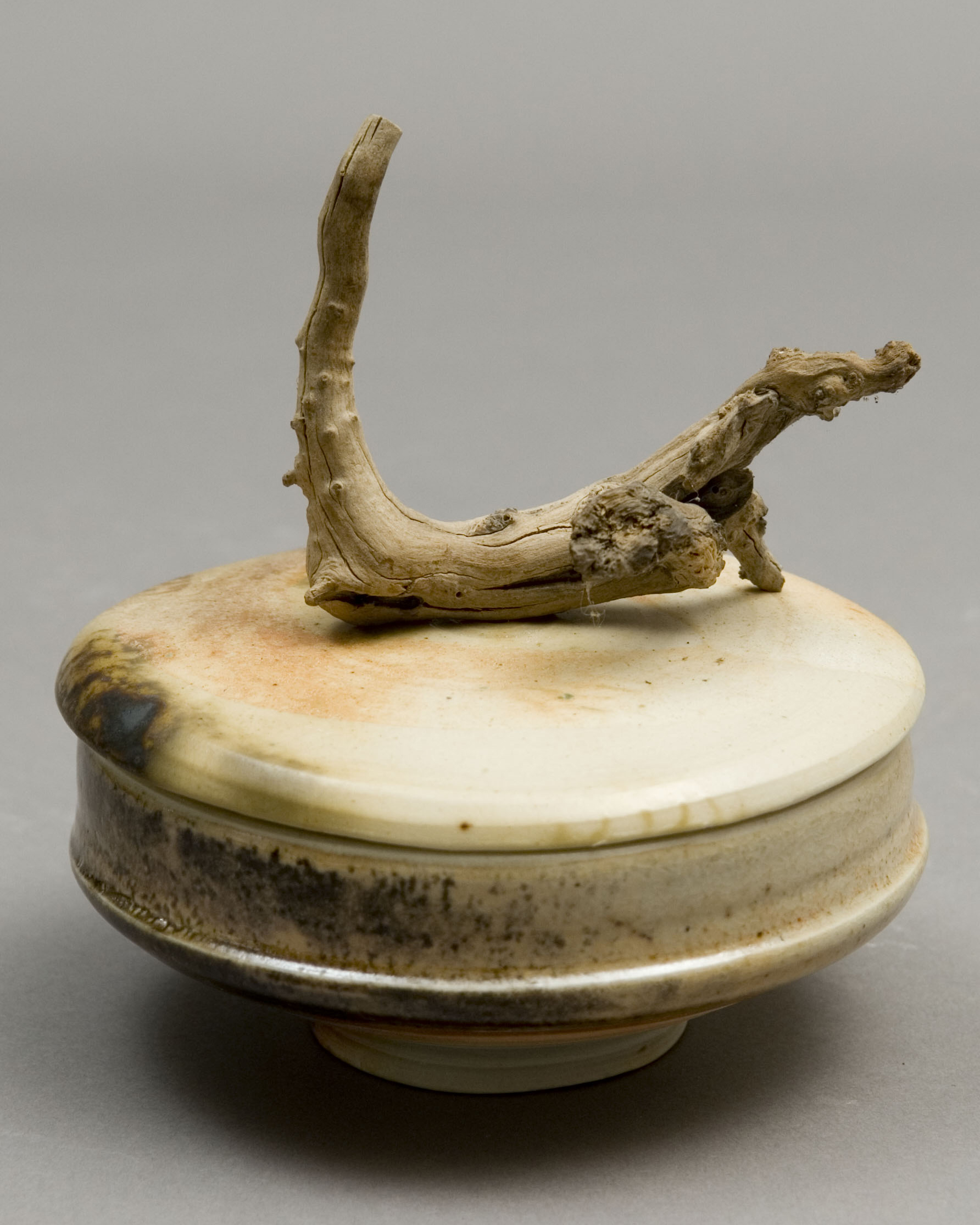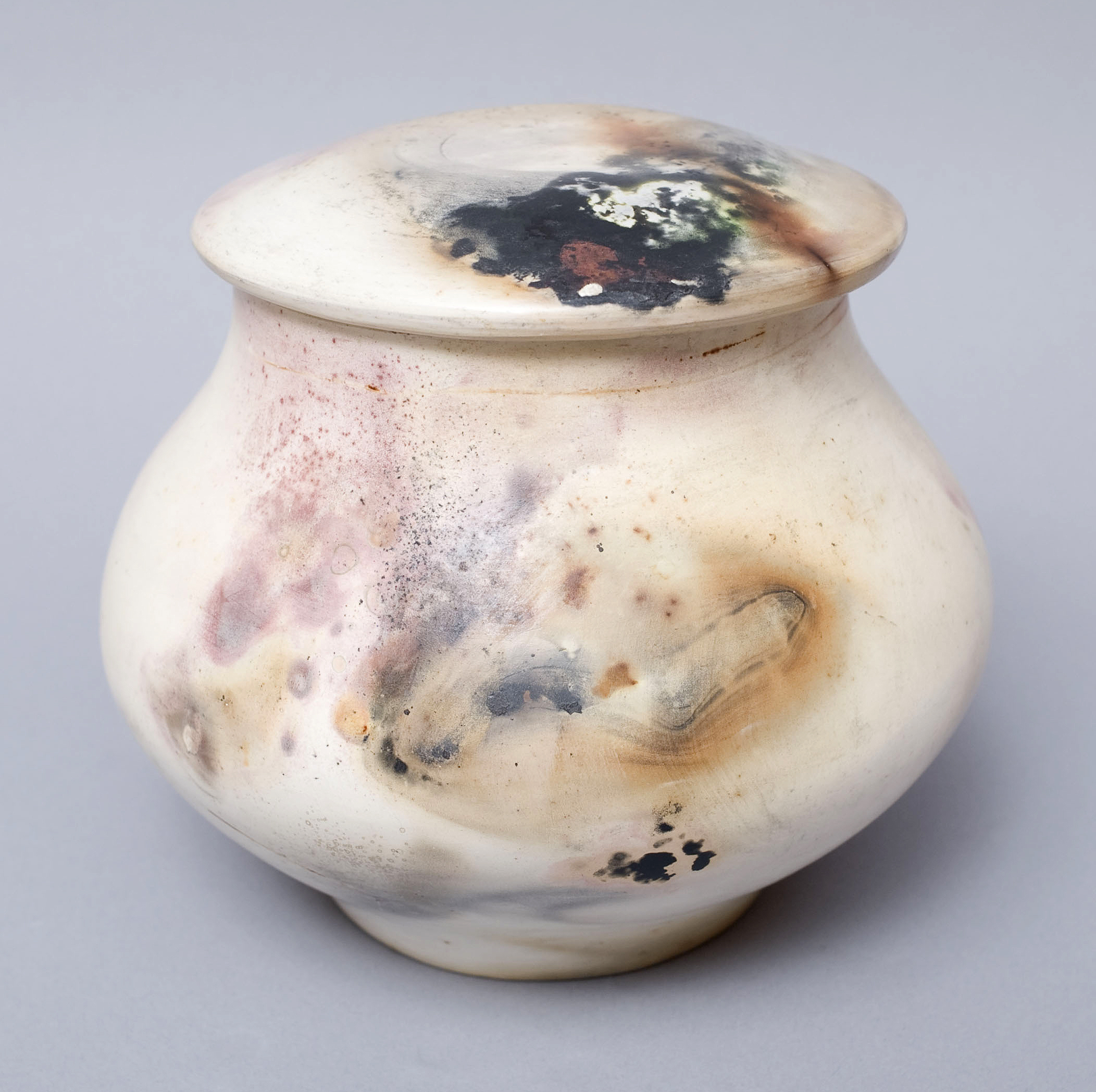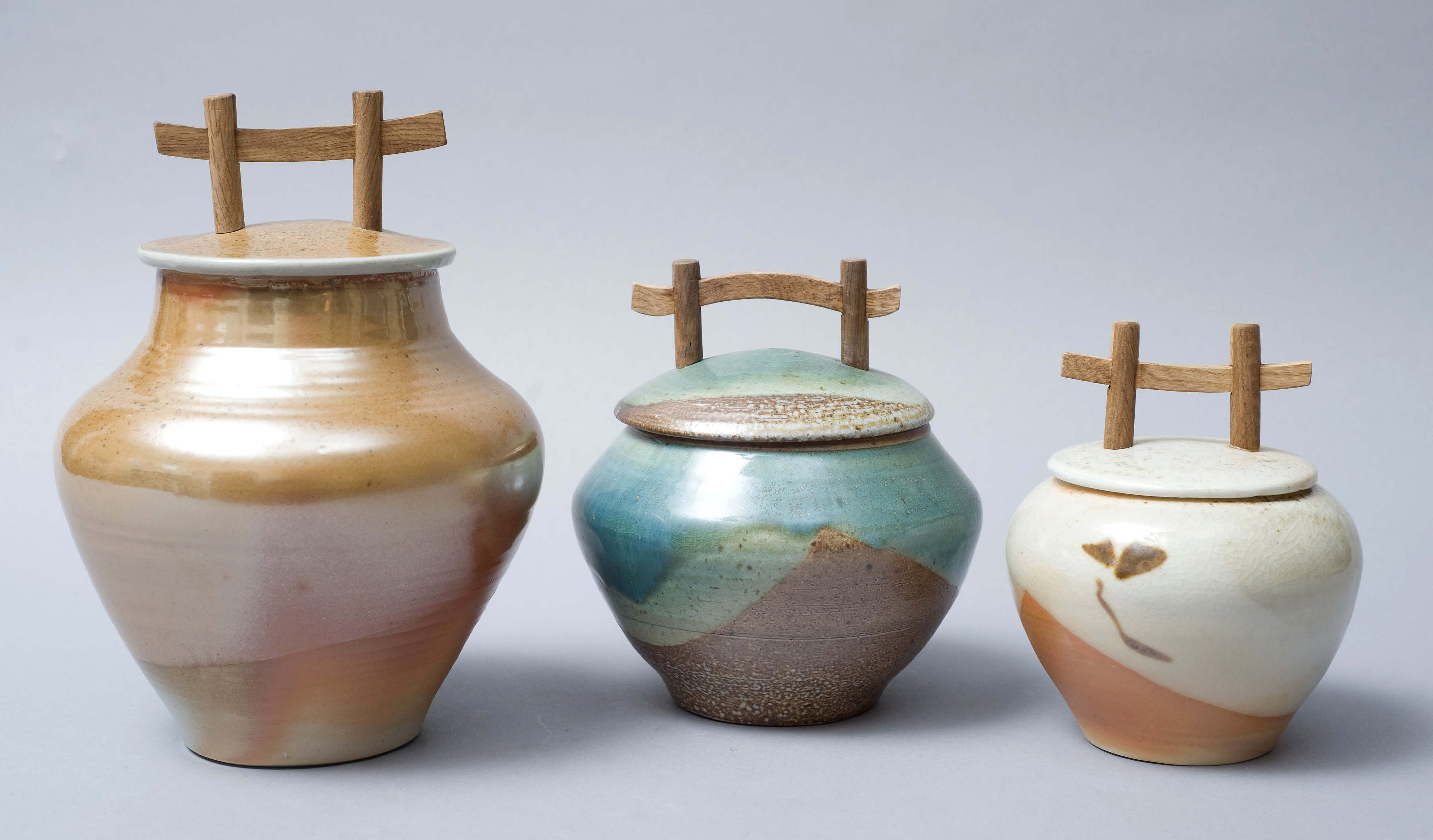Work samples
-
 Tall Red with ShouldersReflections by John Viles on "Tall Red with Shoulders" October 2018: The collaboration began with a drawing of a broad shouldered, tall standing vessel with measurements indicated. Pat came highly recommended as one of the best ceramists on the wheel. We discussed how to proceed including her husband Dale a fine woodworker. So Pat made a beautiful, smooth tall vessel and at the very bottom of the vessel are four small circles representing wheels. My father was in the car business and would have appreciated this small detail on his Urn. Dale made a zebra wood lid fitting perfectly. Afterwards, I painted and put multiple coats of gloss over the fire engine red (my father’s favorite color). This collaboration was very important to me. As an artist, I have never experienced anything similar.
Tall Red with ShouldersReflections by John Viles on "Tall Red with Shoulders" October 2018: The collaboration began with a drawing of a broad shouldered, tall standing vessel with measurements indicated. Pat came highly recommended as one of the best ceramists on the wheel. We discussed how to proceed including her husband Dale a fine woodworker. So Pat made a beautiful, smooth tall vessel and at the very bottom of the vessel are four small circles representing wheels. My father was in the car business and would have appreciated this small detail on his Urn. Dale made a zebra wood lid fitting perfectly. Afterwards, I painted and put multiple coats of gloss over the fire engine red (my father’s favorite color). This collaboration was very important to me. As an artist, I have never experienced anything similar. -
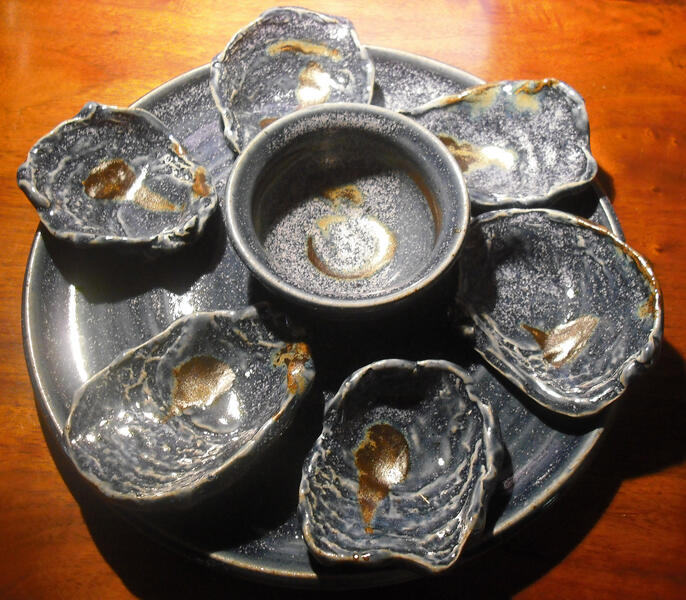 Oyster plateJust search around about oyster plates and you'll find an endless variety from all over the world, over hundreds of years. You find them in all shapes with a variety of surfaces; some are hand-painted with gold leaf, intricate designs and decoration. These are my interpretation of the traditional oyster plate. The clay was stretched over an oyster shell and attached to the wheel-thrown plate. The sauce dish is free standing.
Oyster plateJust search around about oyster plates and you'll find an endless variety from all over the world, over hundreds of years. You find them in all shapes with a variety of surfaces; some are hand-painted with gold leaf, intricate designs and decoration. These are my interpretation of the traditional oyster plate. The clay was stretched over an oyster shell and attached to the wheel-thrown plate. The sauce dish is free standing.
About Pat

Trained by friend and mentor Mary Nyburg, with periods of study at Penland and Haystack, Pat Halle has been a studio potter for over forty years in Baltimore, making primarily functional porcelain pots. She is a long time member of Baltimore Clayworks and worked for 37 years at Disability Rights Maryland. More recently her work in clay includes porcelain and white stoneware sculptural forms fired at low temperatures in sawdust, copper and salt: also drums, funerary ware, covered… more
Jump to a project:
Collaborations with Effie Gereny, painter
Adventuring from work on the wheel and decades of functional pots, I began working on a series of wall pieces involving clay shards, exploring surface, color, and the effects of fire. Breaking larger pieces and then assembling and reassembling them. Broken/mended, serves as a metaphor for how we lose and find our footing again and again.
Locating and placing the clay pieces onto the painting is both spontaneous and carefully considered. Such a pleasure to learn and appreciate Effie's vision and imagination as we create individual wall pieces with painted surfaces and applied clay shards.
Locating and placing the clay pieces onto the painting is both spontaneous and carefully considered. Such a pleasure to learn and appreciate Effie's vision and imagination as we create individual wall pieces with painted surfaces and applied clay shards.
-
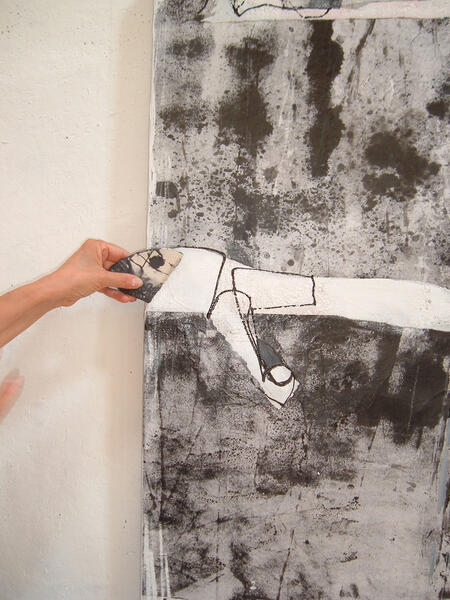 Applying clay shard to sumi-e ink painting
Applying clay shard to sumi-e ink painting -
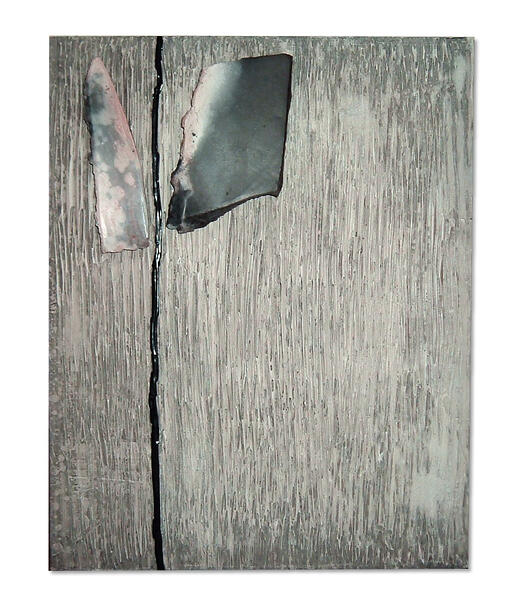 Shards and painted wood
Shards and painted wood -
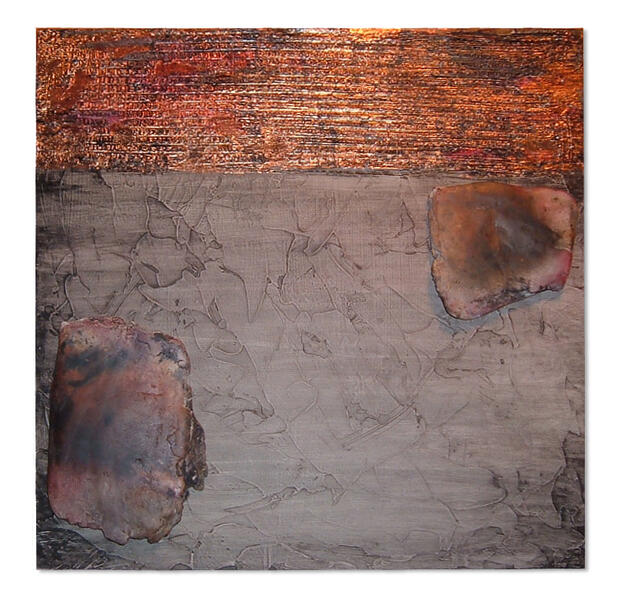 Shards and painted wood
Shards and painted wood -
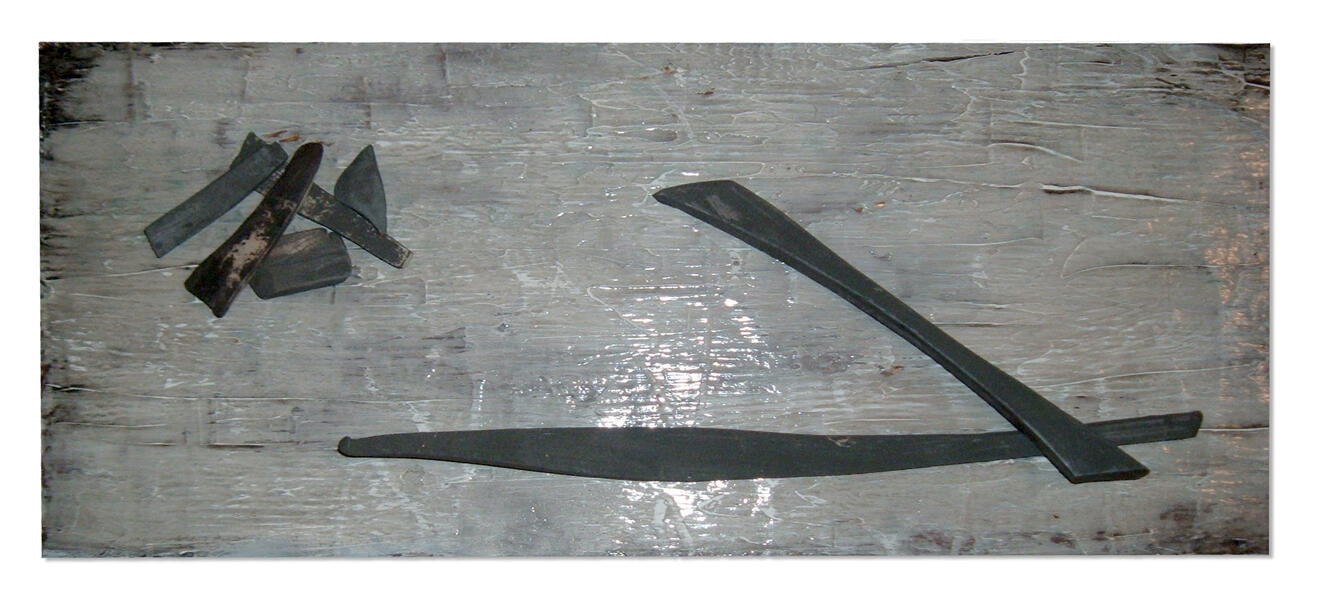 Shards and painted wood wall piece
Shards and painted wood wall piece -
 Wall piece in two partsEach piece is 6 feet long and 2 feet wide and is made of clay shards arranged on a painted wood surface. The shared experience the Effie and I have decorating the painting with the clay pieces is at once spontaneous and thoughtful.
Wall piece in two partsEach piece is 6 feet long and 2 feet wide and is made of clay shards arranged on a painted wood surface. The shared experience the Effie and I have decorating the painting with the clay pieces is at once spontaneous and thoughtful. -
 Shards on canvas
Shards on canvas
The Low Temperature Firing Process
The brick kiln structure has a fire pit underneath which allows stoking with good-sized logs over a period of 5-6 hours in order to achieve a temperature of 1000 degrees. The pots are wrapped in copper wire, seaweed, and straw. The pots are then packed into saggars, containers that hold the pots during the firing process. The saggars are filled with sawdust, copper carbonate and salt and they rest in a larger bed of sawdust, copper carbonate, and salt. As the temperature rises, the chemicals become gaseous, fuming the surfaces with lustrous colors as the fire, smoke, and gasses travel across the pots. After the kiln cools overnight, I carefully unload each piece from the ashes. Every piece is different and surprising. This process is only for those who delight in the unpredictable and unexpected.
-
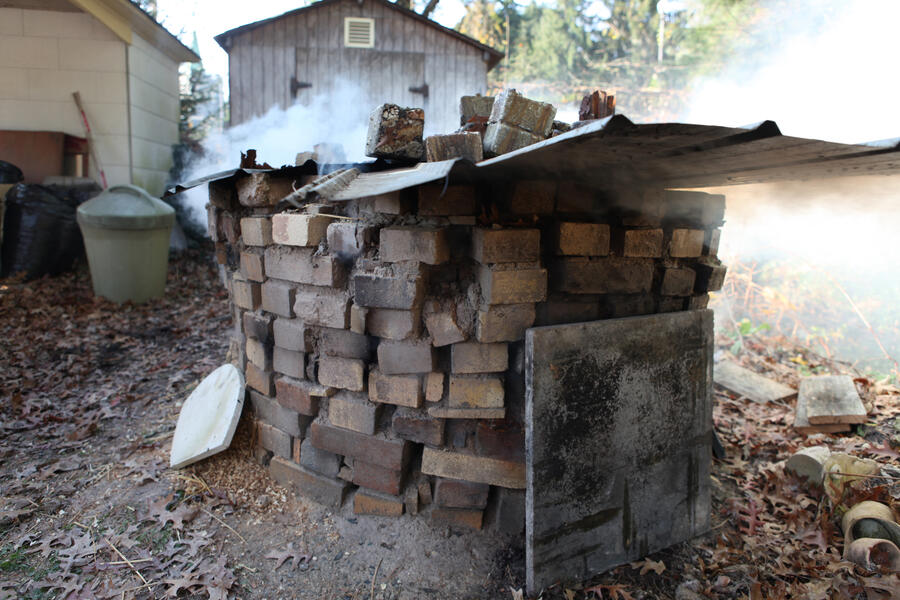 KilnThe sawdust begins to burn in the early stages of the firing.
KilnThe sawdust begins to burn in the early stages of the firing. -
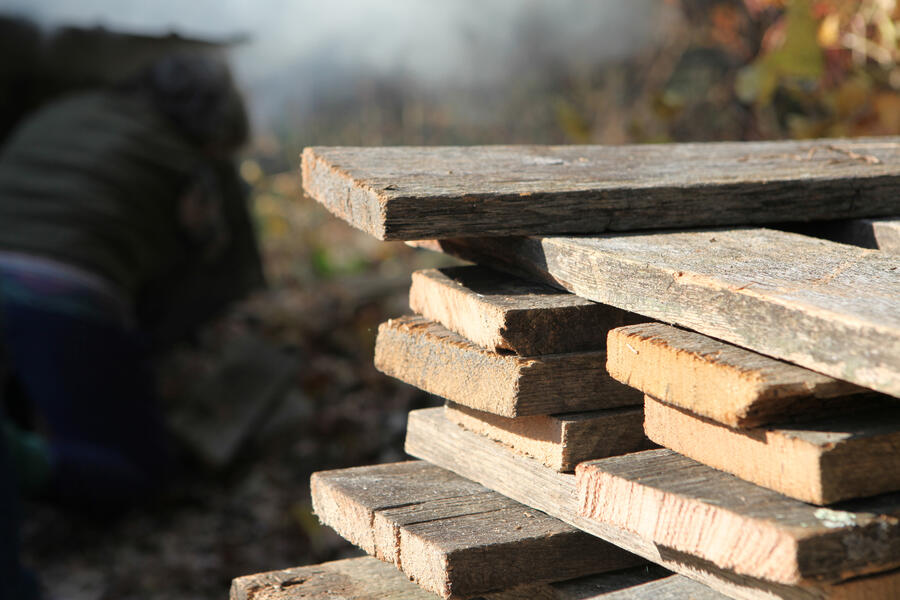 Reusing oak fence wood
Reusing oak fence wood -
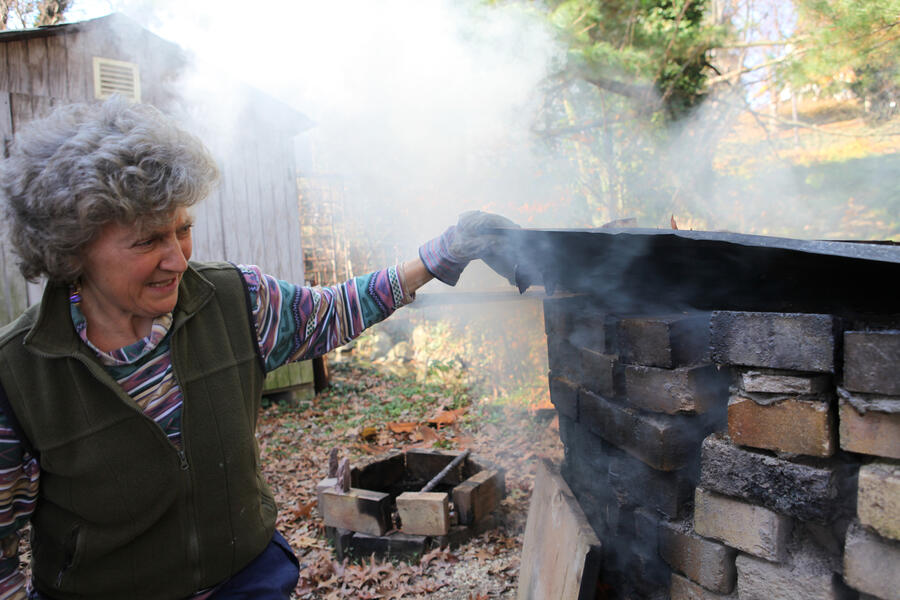 Checking the flame colorIn this process I gauge the temperature by the the color of the flames.
Checking the flame colorIn this process I gauge the temperature by the the color of the flames. -
 Stoking
Stoking -
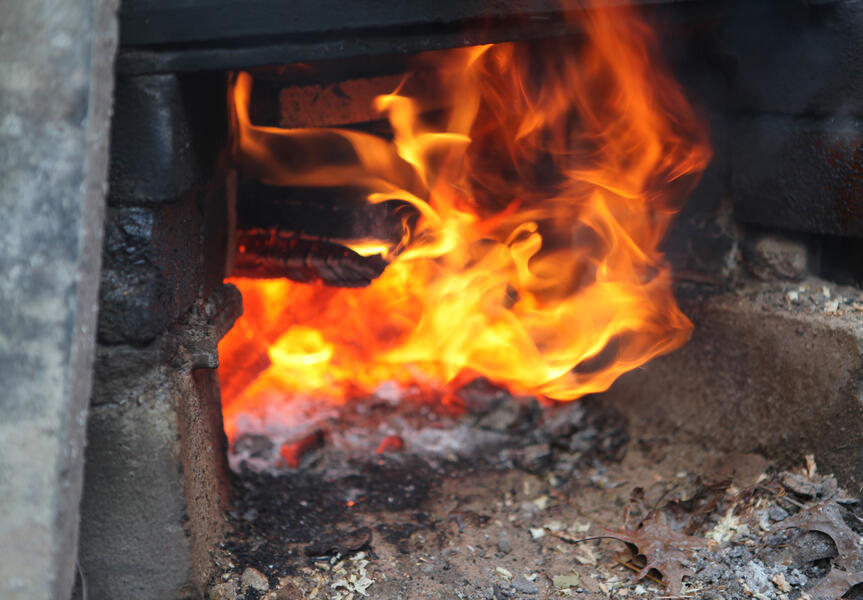 Flame in the burner port
Flame in the burner port -
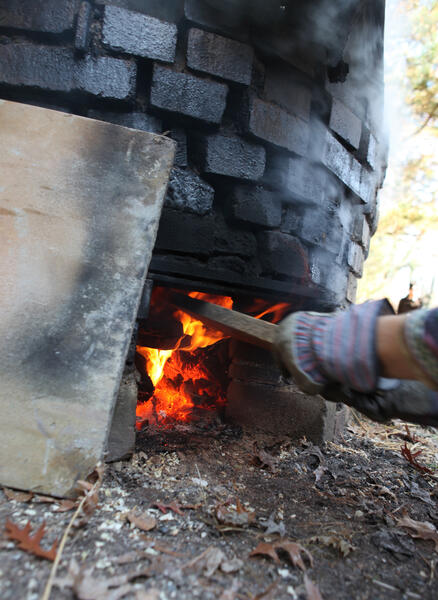 Stoking
Stoking -
 UnloadingAfter the kiln cools, I remove the cover and carefully unpack the pieces which often shift a bit during the intense firing process. They are covered with ash and pieces of the clay saggars.
UnloadingAfter the kiln cools, I remove the cover and carefully unpack the pieces which often shift a bit during the intense firing process. They are covered with ash and pieces of the clay saggars. -
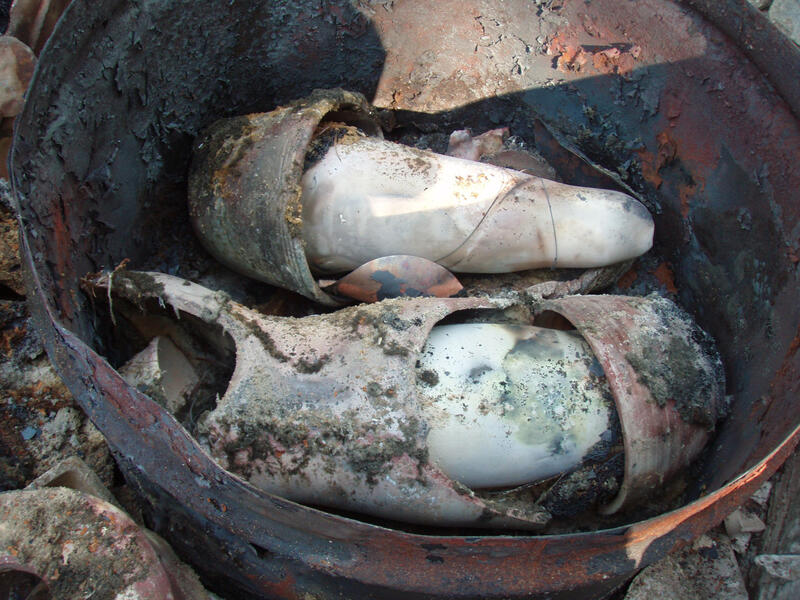 Cooled forms resting in saggars and ashesAfter countless hours of preparation, all potters arrive with great anticipation at the moment of unloading finished work. The forms lie there covered with ashes, surrounded by pieces of firing materials. I can already see patches of colors against the white surface of the clay body.
Cooled forms resting in saggars and ashesAfter countless hours of preparation, all potters arrive with great anticipation at the moment of unloading finished work. The forms lie there covered with ashes, surrounded by pieces of firing materials. I can already see patches of colors against the white surface of the clay body. -
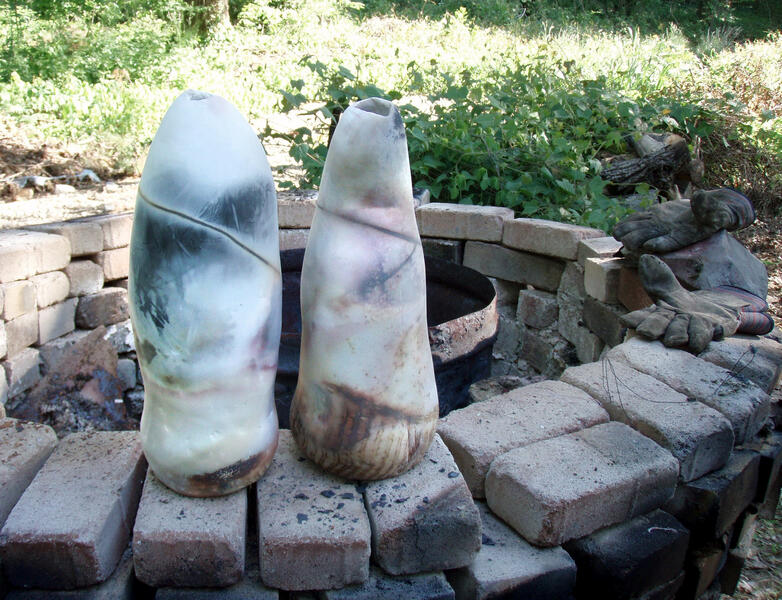 Out of the ashesAnd here they stand just after the unloading. The surfaces will then be rubbed clean and polished to bring out all the colors.
Out of the ashesAnd here they stand just after the unloading. The surfaces will then be rubbed clean and polished to bring out all the colors. -
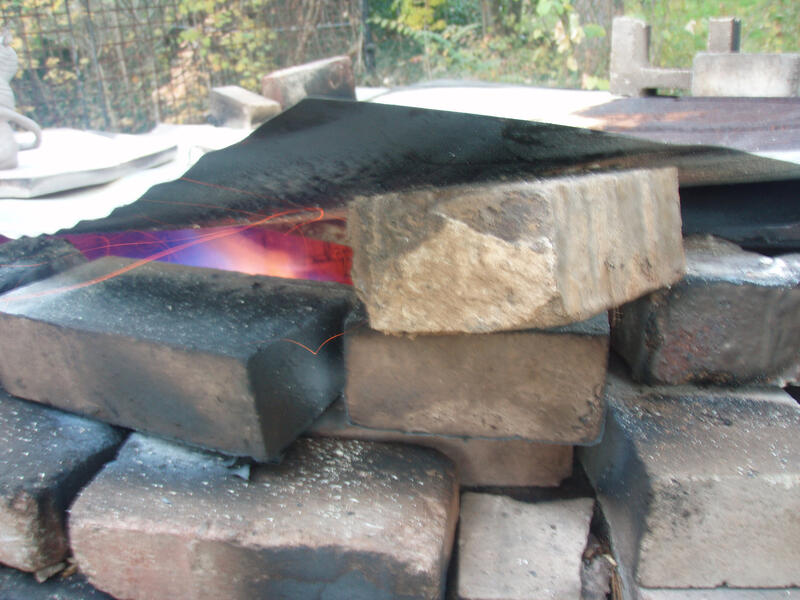 FlamesPotters work closely with the fire, always with great respect for its power. I love this firing process because of the intimate contact with the smoke and fire. It's a dramatic and delicate dance with the flames and fumes as they decorate the surfaces of the pieces.
FlamesPotters work closely with the fire, always with great respect for its power. I love this firing process because of the intimate contact with the smoke and fire. It's a dramatic and delicate dance with the flames and fumes as they decorate the surfaces of the pieces.
Oyster Plates
I've recently personalized and reinvented the traditional oyster plate after receiving an invitation from the Oyster Recovery Partnership (ORP.) ORP wanted to give oyster plates as an award to Senator Barbara Mikulski and citizen Anne Johnson. My work in oysters is inspired by my husband's project, The Wye Oak Commemorative Oyster Knife, completed with our oyster-shucking friends, George Hastings and Paul Bartlett.
-
 Oyster plate with dish for cocktail sauceJust search around about oyster plates and you'll find an endless variety from all over the world, over hundreds of years. You find them in all shapes with a variety of surfaces; some are hand-painted with gold leaf, intricate designs and decoration. These are my interpretation of the traditional oyster plate. The clay was stretched over an oyster shell and attached to the wheel-thrown plate. The sauce dish is free standing.
Oyster plate with dish for cocktail sauceJust search around about oyster plates and you'll find an endless variety from all over the world, over hundreds of years. You find them in all shapes with a variety of surfaces; some are hand-painted with gold leaf, intricate designs and decoration. These are my interpretation of the traditional oyster plate. The clay was stretched over an oyster shell and attached to the wheel-thrown plate. The sauce dish is free standing. -
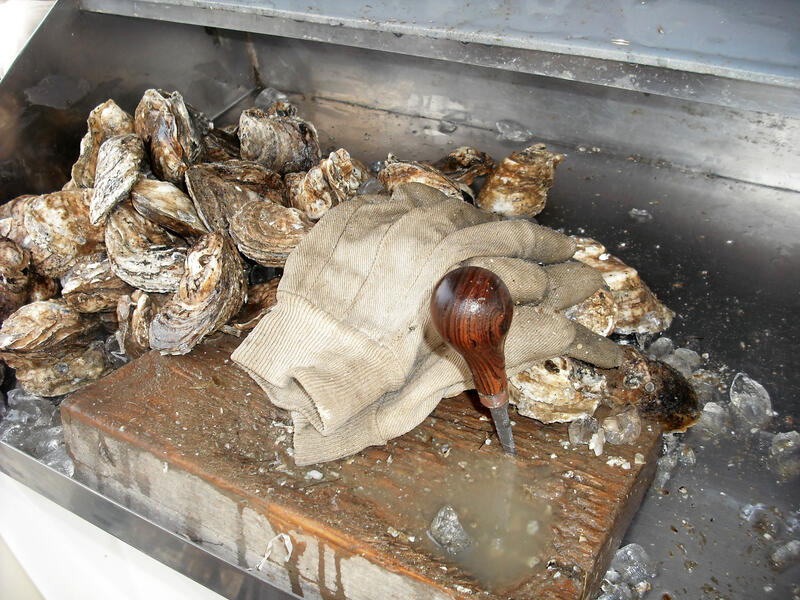 Oysters waiting to be shucked and servedThe shucking knife pictured here is fashioned by Dale German. The handle is made out of Wye Oak Wood.
Oysters waiting to be shucked and servedThe shucking knife pictured here is fashioned by Dale German. The handle is made out of Wye Oak Wood. -
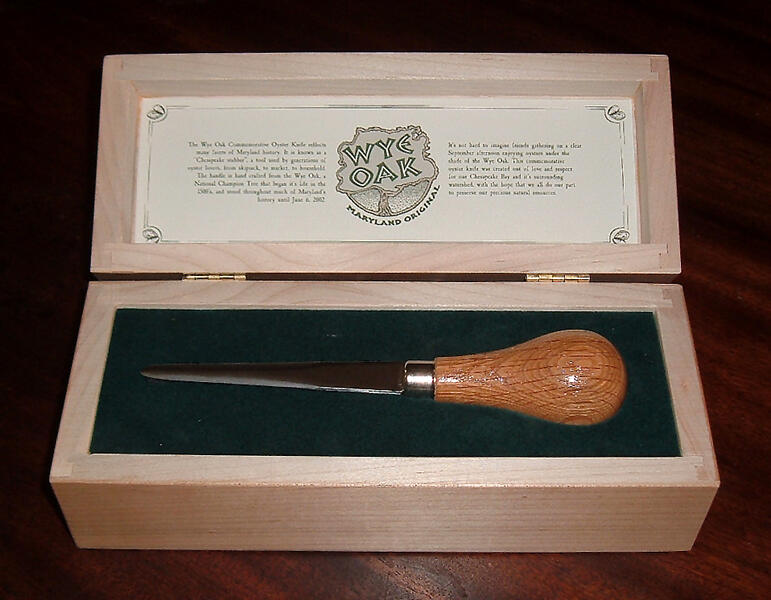 Wye Oak Commemorative Oyster KnifeThe Oyster Knife made with wood from the famous Wye Oak Tree was a fundraising project for the Oyster Recovery Partnership. A blend of local history and industry, culinary arts and craftsmanship, the project was the joint venture of Dale German, George Hastings, and Paul Bartlett.
Wye Oak Commemorative Oyster KnifeThe Oyster Knife made with wood from the famous Wye Oak Tree was a fundraising project for the Oyster Recovery Partnership. A blend of local history and industry, culinary arts and craftsmanship, the project was the joint venture of Dale German, George Hastings, and Paul Bartlett. -
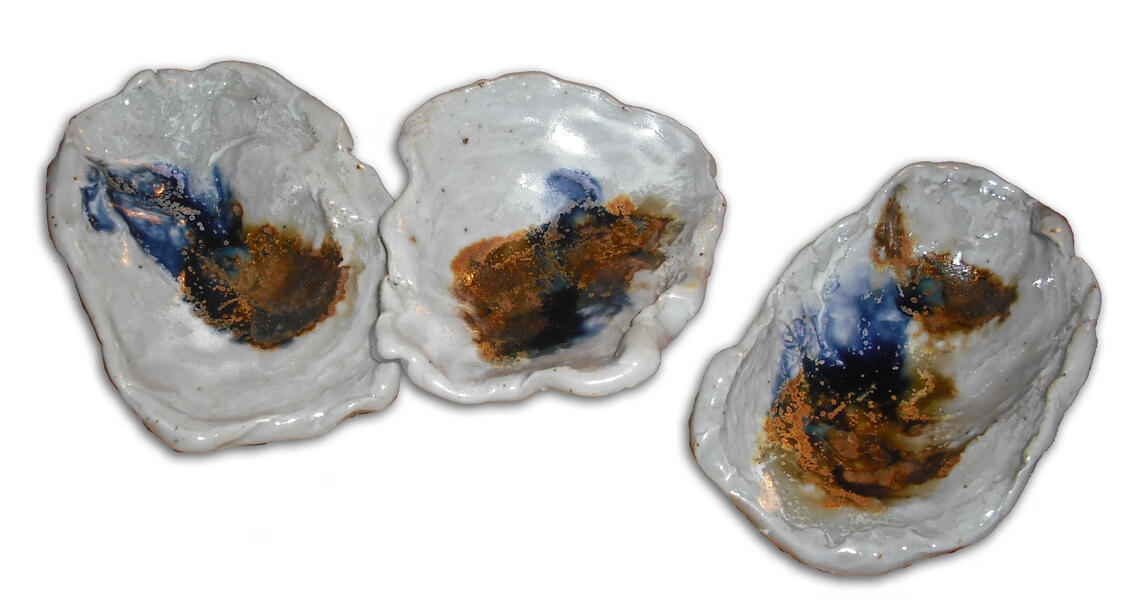 oyster plate parts
oyster plate parts -
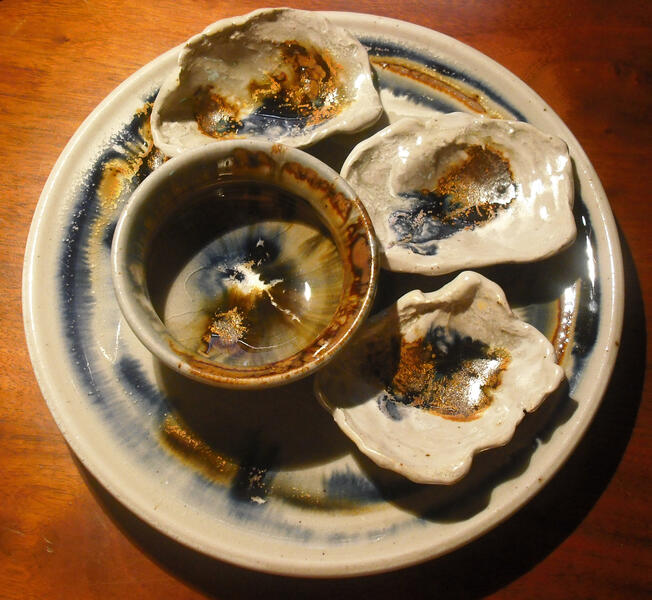 Oyster plate with dish for cocktail sauce
Oyster plate with dish for cocktail sauce -
 Oyster plateJust search around about oyster plates and you'll find an endless variety from all over the world, over hundreds of years. You find them in all shapes with a variety of surfaces; some are hand-painted with gold leaf, intricate designs and decoration. These are my interpretation of the traditional oyster plate. The clay was stretched over an oyster shell and attached to the wheel-thrown plate. The sauce dish is free standing.
Oyster plateJust search around about oyster plates and you'll find an endless variety from all over the world, over hundreds of years. You find them in all shapes with a variety of surfaces; some are hand-painted with gold leaf, intricate designs and decoration. These are my interpretation of the traditional oyster plate. The clay was stretched over an oyster shell and attached to the wheel-thrown plate. The sauce dish is free standing.
Collaborations with Dale German/ Singing, Dancing, Washing, Dying
Collaborations with my husband, Dale German, master cabinetmaker:
Singing, Dancing, Washing, Dying.
These collaborative pieces include drums, sinks, funerary urns, and other containers for all kinds of uses. Sinks rest in custom-made wooden cabinets; containers and drums are wheel-thrown and fired at both high and low temperatures. The sizes range from 4-14" in height. Dale and I explore form and function that lend themselves to the combination of clay and wood, including handles, knobs, lids with wood and clay shards, and framed wall pieces. Most often I present Dale with the finished clay piece and he brings his artistry and craftsmanship to design the wood elements. What an interesting process to learn and appreciate Dale's imagination and unique artistic sensibility in this collaborative work.
Singing, Dancing, Washing, Dying.
These collaborative pieces include drums, sinks, funerary urns, and other containers for all kinds of uses. Sinks rest in custom-made wooden cabinets; containers and drums are wheel-thrown and fired at both high and low temperatures. The sizes range from 4-14" in height. Dale and I explore form and function that lend themselves to the combination of clay and wood, including handles, knobs, lids with wood and clay shards, and framed wall pieces. Most often I present Dale with the finished clay piece and he brings his artistry and craftsmanship to design the wood elements. What an interesting process to learn and appreciate Dale's imagination and unique artistic sensibility in this collaborative work.
-
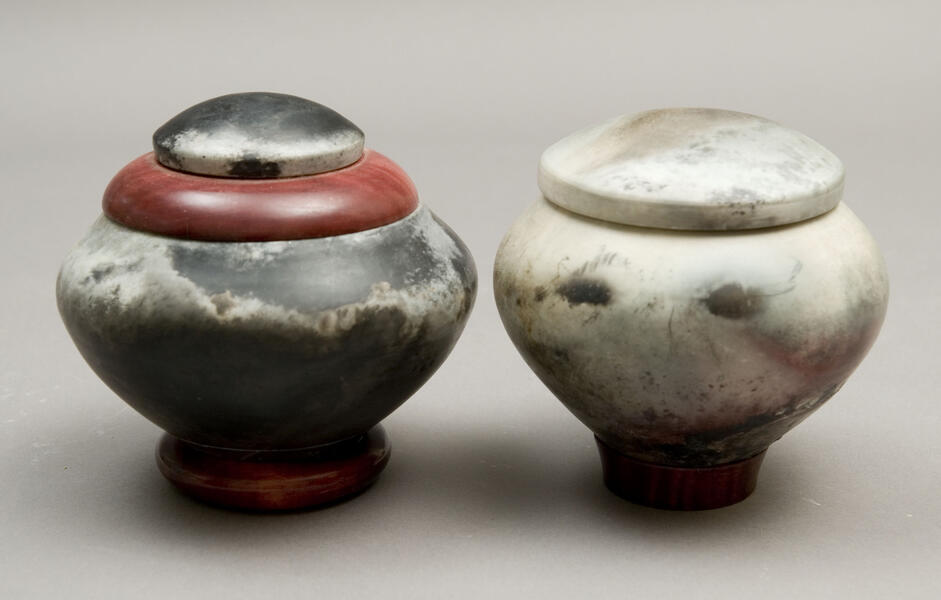 Containers with wooden parts
Containers with wooden parts -
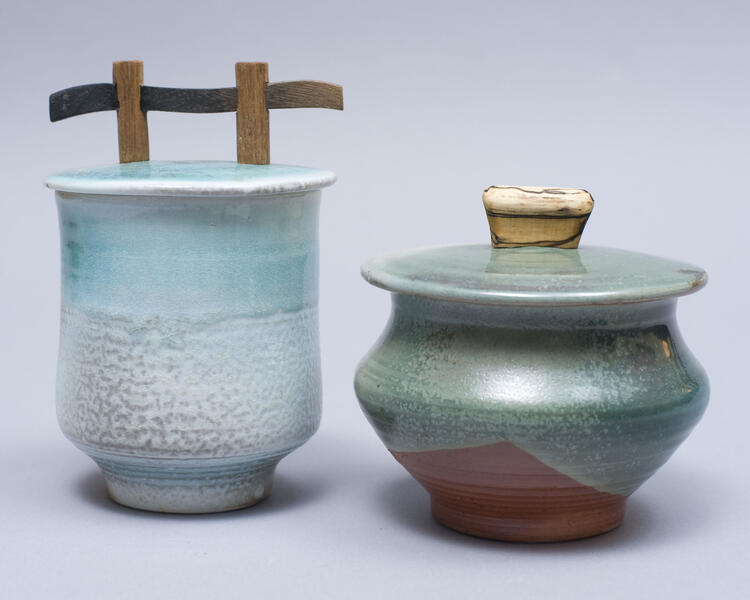 Containers with Wye Oak and maple handlesThese containers are fired at high temperatures in the soda section of the wood kiln at Baltimore Clayworks, revealing lustrous texture, depth, and color.
Containers with Wye Oak and maple handlesThese containers are fired at high temperatures in the soda section of the wood kiln at Baltimore Clayworks, revealing lustrous texture, depth, and color. -
 Containers with Wye Oak handles
Containers with Wye Oak handles -
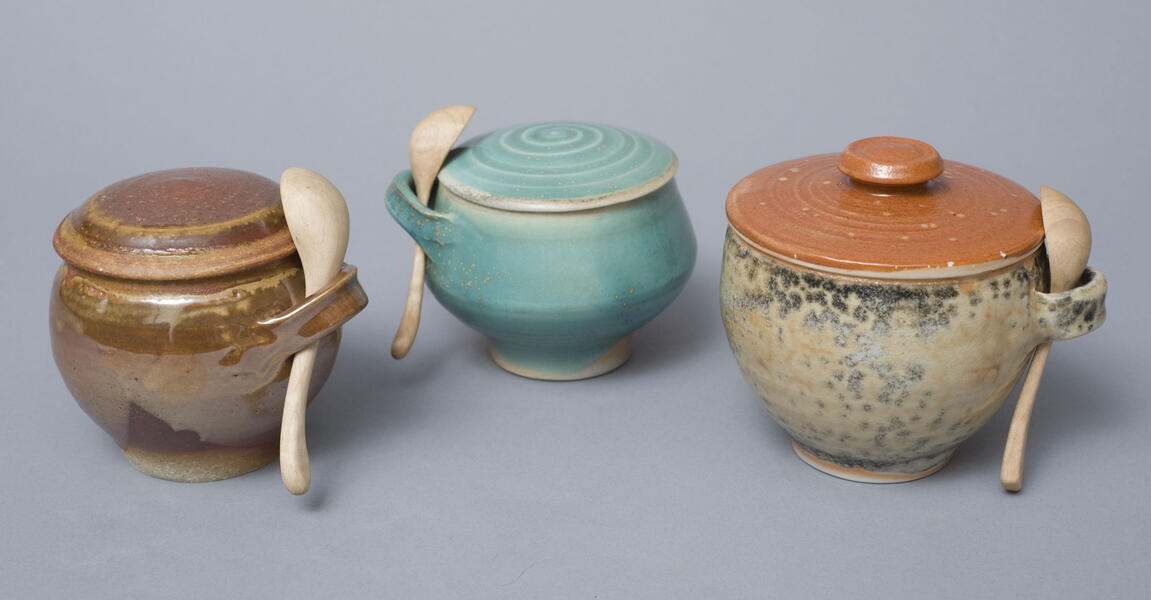 Sugar bowls with handmade wooden spoons
Sugar bowls with handmade wooden spoons -
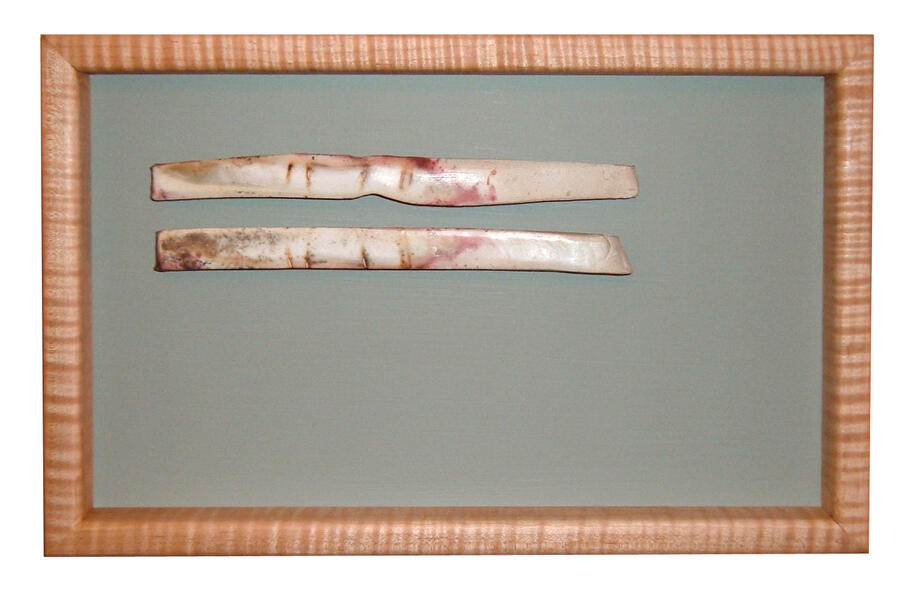 Wall piece, shards on painted wood in maple frame
Wall piece, shards on painted wood in maple frame -
 Container with Wye Oak handle
Container with Wye Oak handle -
 Container with clay/wood lid
Container with clay/wood lid -
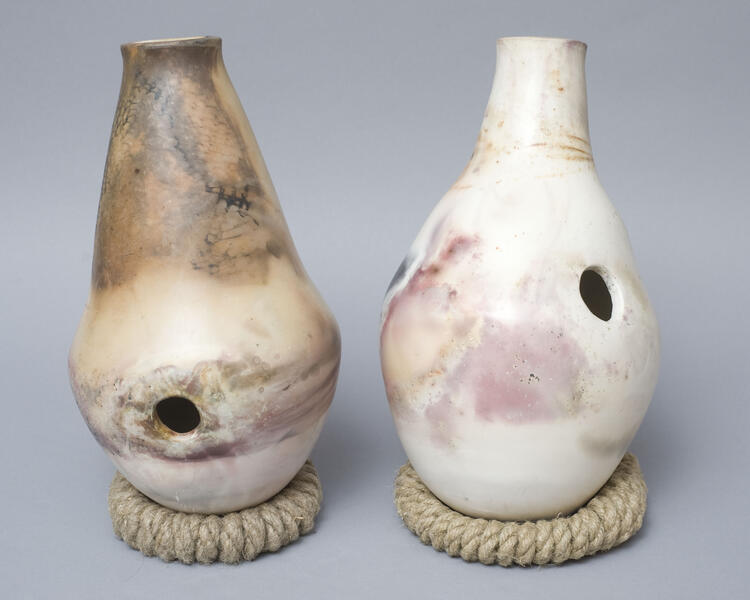 Udus, clay pot drums, 12" heightHemp bases fashioned by Dale German.
Udus, clay pot drums, 12" heightHemp bases fashioned by Dale German. -
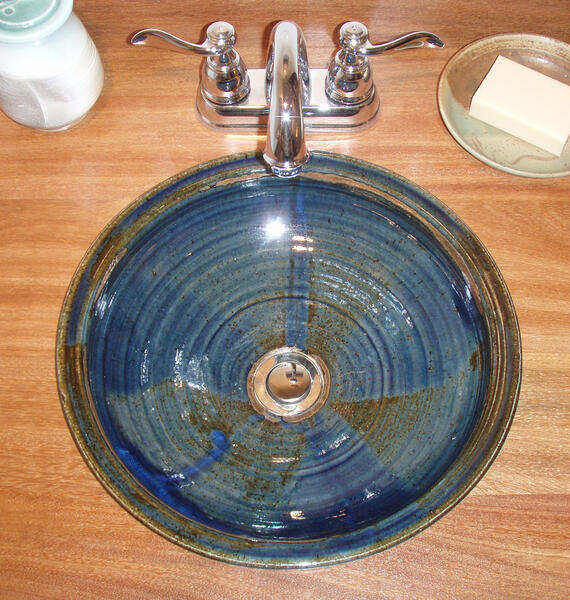 Sink with custom cabinet
Sink with custom cabinet -
 Container with Wye Oak handle
Container with Wye Oak handle
Sculptural Forms
These are hand built sculptural forms made with coils of clay over a period of weeks. Each pot is burnished until very smooth, and then fired with wood as the fuel in a dramatic hands-on process. The temperature reaches approximately 1000 degrees. The pieces are packed into saggars, clay containers that protect them and affect the flow of smoke and flame across the surfaces during the firing process. Each piece is surrounded by sawdust, seaweed, straw, copper, and salt, decorated with copper wire and string. The loading and packing of each pot and the play of fire and smoke during the firing combine to make unique and wonderfully unpredictable marks on the surfaces of the pots.
Each form is 14-16 inches in height, 6-7 inches in diameter. Loading and firing takes about 6-7 hours. Unloading the pieces after an overnight cool-down is always surprising.
Each form is 14-16 inches in height, 6-7 inches in diameter. Loading and firing takes about 6-7 hours. Unloading the pieces after an overnight cool-down is always surprising.
-
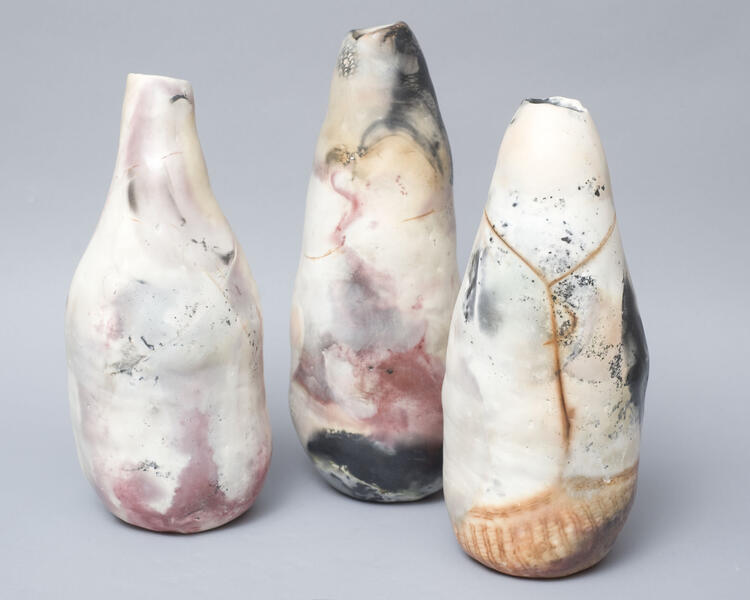 Group of forms, 14-16" tallThese are hand built sculptural forms made with coils of clay over a period of weeks. Each pot is burnished until very smooth, and then fired with wood as the fuel in a dramatic hands-on process.
Group of forms, 14-16" tallThese are hand built sculptural forms made with coils of clay over a period of weeks. Each pot is burnished until very smooth, and then fired with wood as the fuel in a dramatic hands-on process. -
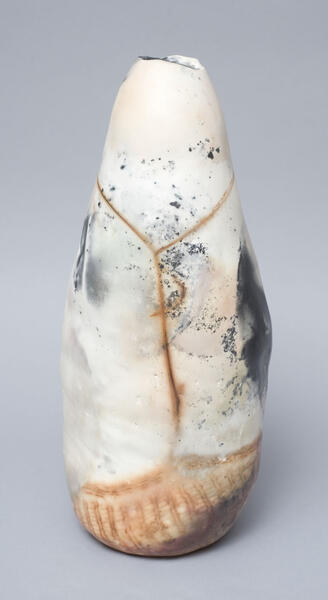 Form 1
Form 1 -
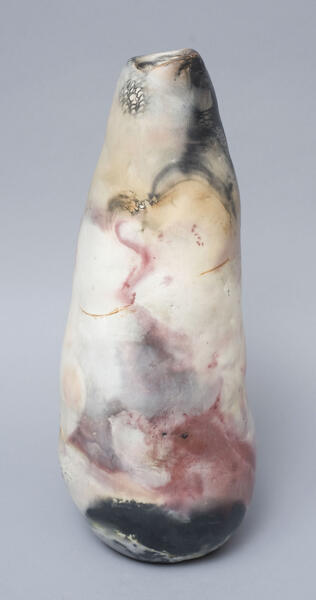 Detail of form surface
Detail of form surface -
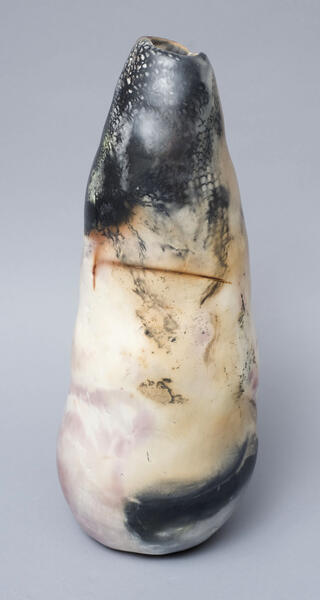 Form #2
Form #2 -
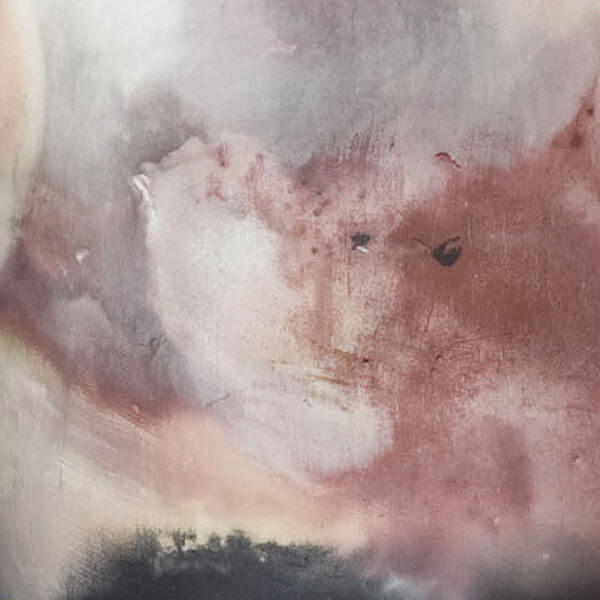 Detail of form surface
Detail of form surface -
 Effects of fire and copper on surface
Effects of fire and copper on surface -
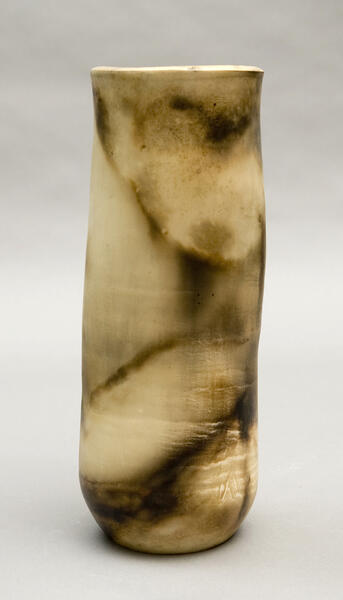 Vase with smoke designs
Vase with smoke designs -
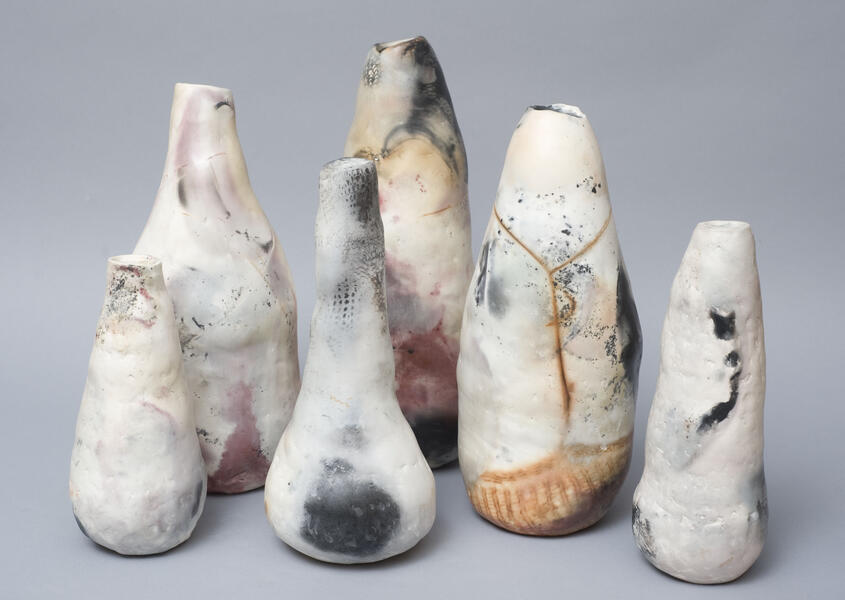 Group of forms
Group of forms
Clay drums
The udu is a Nigerian clay pot drum with an origin in traditional water storage jars. These drums are thrown on the wheel, sometimes in two parts, burnished and then fired in the low temperature sawdust/salt/copper firing process. They range in size from 10-16â? in height, 6-9â? in diameter. The size and the shape of the pot and the openings will affect the tone and penetrating watery sound of each drum. Drums rest on rope stands made of hemp, fashioned by Dale German.
Functional porcelain and stoneware
I have been making pots now for forty years. I thoroughly enjoy the feel of the clay itself and, over so many years, a steady dedication to making affordable objects for daily use. These functional pots are porcelain and white stoneware, fired in a gas kiln to 2300 degrees. Recently I've added a reinterpretation of the traditional oyster plate.
Making bowls and cups and plates, washing clothes, raising kids, going to work, coming home, pulling handles, wedging clay. The passion deepens, the opportunity for creativity expands, seasoned by time and applied practice.
Making bowls and cups and plates, washing clothes, raising kids, going to work, coming home, pulling handles, wedging clay. The passion deepens, the opportunity for creativity expands, seasoned by time and applied practice.
Funerary Ware/ Urns
More and more often I receive requests for cremation urns from family, friends, and others. What an honor after years of making the cups and bowls and plates that fill their kitchens, to now make containers for this purpose. As potters, we think about vessels and shapes and I think of the urns as â??The Shapes of Our Lives.â? Recently friends have asked me to make the urn they will use in the future and will even join me in the studio as I make the urn for them. â??Urns While You Waitâ? gives us the opportunity to hold living and dying all at once with grace, cherishing it all. Some of these pieces with wooden handles are made in collaboration with my husband, master cabinetmaker Dale German, with wood from the Wye Oak and other wood provided by friend Bill Waldman.
Reflections by John Viles on "Tall Red with Shoulders" October 2018
"The collaboration began with a drawing of a broad shouldered, tall standing vessel with measurements indicated. Pat came highly recommended as one of the best ceramists on the wheel. We discussed how to proceed including her husband Dale a fine woodworker. So Pat made a beautiful, smooth tall vessel and at the very bottom of the vessel are four small circles representing wheels. My father was in the car business and would have appreciated this small detail on his Urn. Dale made a zebra wood lid fitting perfectly. Afterwards, I painted and put multiple coats of gloss over the fire engine red (my father’s favorite color). This collaboration was very important to me. As an artist, I have never experienced anything similar."
Reflections by Lee Hoyt on "Urns While You Wait":
"...when we entered Patâ??s studio it became a total immersion experience. I discovered the smell of the clay in its various stages of dampness or drying, the physical sensations of playing with pieces of clay as I watched Pat working at her wheel, and the mesmerizing sight of Patâ??s hands guiding the clay from shapelessness up and down and out and into voluptuous vessels and perfectly fitted lids.
...At first glance the urns are full of air and empty of everything else. But upon further contemplation I see more broadly, understanding the many elements that came together for the potter to be alive, for the earth to create the clay, the water used to form the urn, the wood for the fire required to harden the urn and to fashion handles, the trees from which the wood came that required sunlight and water and nourishment from the earth, the people who transported the materials, and so on â?¦ the urns are interconnected to everything else in the universe by this reasoning. And the urns are full of the whole universe, though they are impermanent, just as my body is full of everything, connected to it all, but impermanent."
Reflections by John Viles on "Tall Red with Shoulders" October 2018
"The collaboration began with a drawing of a broad shouldered, tall standing vessel with measurements indicated. Pat came highly recommended as one of the best ceramists on the wheel. We discussed how to proceed including her husband Dale a fine woodworker. So Pat made a beautiful, smooth tall vessel and at the very bottom of the vessel are four small circles representing wheels. My father was in the car business and would have appreciated this small detail on his Urn. Dale made a zebra wood lid fitting perfectly. Afterwards, I painted and put multiple coats of gloss over the fire engine red (my father’s favorite color). This collaboration was very important to me. As an artist, I have never experienced anything similar."
Reflections by Lee Hoyt on "Urns While You Wait":
"...when we entered Patâ??s studio it became a total immersion experience. I discovered the smell of the clay in its various stages of dampness or drying, the physical sensations of playing with pieces of clay as I watched Pat working at her wheel, and the mesmerizing sight of Patâ??s hands guiding the clay from shapelessness up and down and out and into voluptuous vessels and perfectly fitted lids.
...At first glance the urns are full of air and empty of everything else. But upon further contemplation I see more broadly, understanding the many elements that came together for the potter to be alive, for the earth to create the clay, the water used to form the urn, the wood for the fire required to harden the urn and to fashion handles, the trees from which the wood came that required sunlight and water and nourishment from the earth, the people who transported the materials, and so on â?¦ the urns are interconnected to everything else in the universe by this reasoning. And the urns are full of the whole universe, though they are impermanent, just as my body is full of everything, connected to it all, but impermanent."
-
 "Urns While You Wait"Reflections by Lee Hoyt: "Iâ??ve always known I would choose to be cremated, as my parents did, and that I would talk with my family about end of life choices, scattering my ashes and creating a meaningful ritual to mark my passage. But I hadnâ??t thought about the details until I picked up one of Pat Halleâ??s urns and felt its curves so satisfying to the palms of my hands and observed the subtle colors of its dappled surface. It quickly became clear that an urn would be just the right container for what remained of me after my death and before I was scattered to the elements. The process of participating in the design and creation of my urns was a profound gift that I have thought back on many times..."
"Urns While You Wait"Reflections by Lee Hoyt: "Iâ??ve always known I would choose to be cremated, as my parents did, and that I would talk with my family about end of life choices, scattering my ashes and creating a meaningful ritual to mark my passage. But I hadnâ??t thought about the details until I picked up one of Pat Halleâ??s urns and felt its curves so satisfying to the palms of my hands and observed the subtle colors of its dappled surface. It quickly became clear that an urn would be just the right container for what remained of me after my death and before I was scattered to the elements. The process of participating in the design and creation of my urns was a profound gift that I have thought back on many times..." -
 Urn, decorated by smoke and fire
Urn, decorated by smoke and fire -
 urns with wye oak handles
urns with wye oak handles -
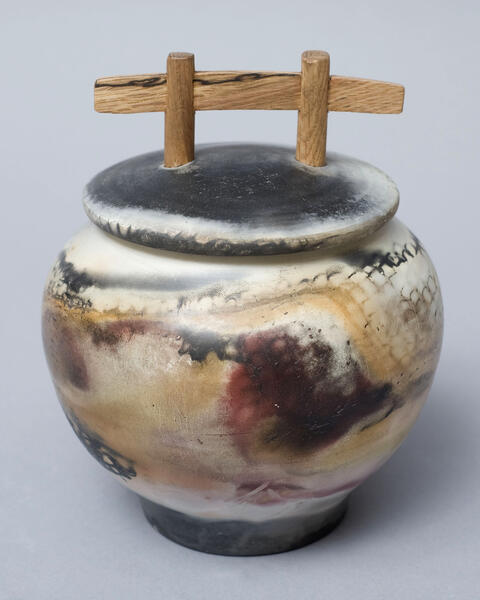 trails of fire
trails of fire -
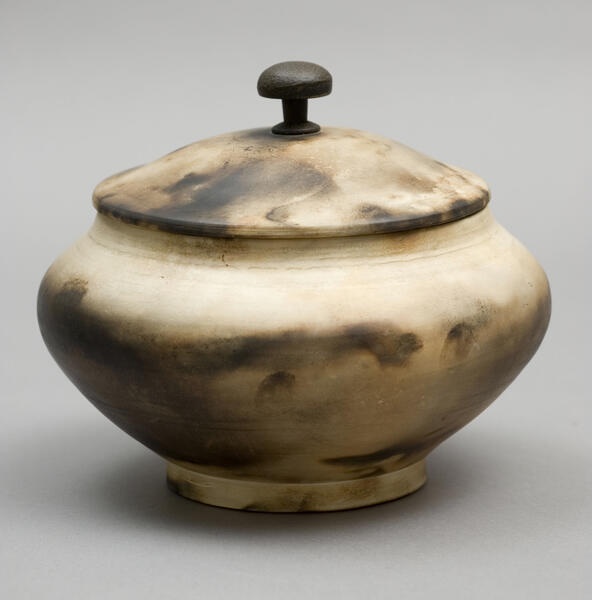 Urn decorated by smoke and sawdust
Urn decorated by smoke and sawdust -
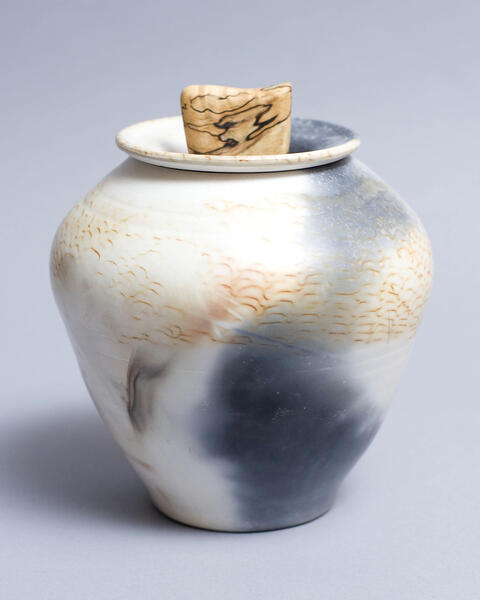 Urn with maple handle
Urn with maple handle -
 Tall Red with ShouldersReflections by John Viles on "Tall Red with Shoulders" October 2018: The collaboration began with a drawing of a broad shouldered, tall standing vessel with measurements indicated. Pat came highly recommended as one of the best ceramists on the wheel. We discussed how to proceed including her husband Dale a fine woodworker. So Pat made a beautiful, smooth tall vessel and at the very bottom of the vessel are four small circles representing wheels. My father was in the car business and would have appreciated this small detail on his Urn. Dale made a zebra wood lid fitting perfectly. Afterwards, I painted and put multiple coats of gloss over the fire engine red (my father’s favorite color). This collaboration was very important to me. As an artist, I have never experienced anything similar.
Tall Red with ShouldersReflections by John Viles on "Tall Red with Shoulders" October 2018: The collaboration began with a drawing of a broad shouldered, tall standing vessel with measurements indicated. Pat came highly recommended as one of the best ceramists on the wheel. We discussed how to proceed including her husband Dale a fine woodworker. So Pat made a beautiful, smooth tall vessel and at the very bottom of the vessel are four small circles representing wheels. My father was in the car business and would have appreciated this small detail on his Urn. Dale made a zebra wood lid fitting perfectly. Afterwards, I painted and put multiple coats of gloss over the fire engine red (my father’s favorite color). This collaboration was very important to me. As an artist, I have never experienced anything similar.
